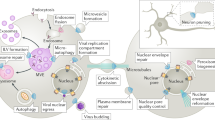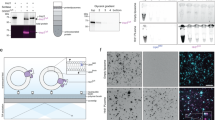Abstract
The ubiquitin system targets many cellular proteins. Doa10 (also known as Ssm4), a yeast transmembrane ubiquitin ligase (E3), resides in the endoplasmic reticulum (ER), but it attaches ubiquitin to soluble proteins that concentrate in the nucleus. A central question is how nuclear substrates gain access to an enzyme in the ER. Here we show that Doa10 reaches the inner nuclear membrane. A subcomplex of nuclear pore subunits is important for this transport. Notably, another ER transmembrane E3, Hrd1 (also known as Der3), cannot localize efficiently to the inner nuclear membrane. Tethering Doa10 at the cell periphery inhibits degradation of soluble nuclear substrates but not cytoplasmic ones. If Doa10 is released from these peripheral sites, localization of Doa10 to the nuclear envelope and degradation of its nuclear substrates are restored in parallel. Thus, localization of Doa10 to the inner nuclear membrane is necessary for nuclear substrate degradation. These data indicate that different membrane ubiquitin ligases are spatially sorted within the ER–nuclear envelope membrane system and that this differential localization contributes to their specificity.
This is a preview of subscription content, access via your institution
Access options
Subscribe to this journal
Receive 51 print issues and online access
$199.00 per year
only $3.90 per issue
Buy this article
- Purchase on Springer Link
- Instant access to full article PDF
Prices may be subject to local taxes which are calculated during checkout




Similar content being viewed by others
References
Hochstrasser, M. Ubiquitin-dependent protein degradation. Annu. Rev. Genet. 30, 405–439 (1996)
Hershko, A. & Ciechanover, A. The ubiquitin system. Annu. Rev. Biochem. 67, 425–479 (1998)
Pickart, C. M. & Eddins, M. J. Ubiquitin: structures, functions, mechanisms. Biochim. Biophys. Acta 1695, 55–72 (2004)
Varshavsky, A. Regulated protein degradation. Trends Biochem. Sci. 30, 283–286 (2005)
Pines, J. & Lindon, C. Proteolysis: anytime, any place, anywhere?. Nature Cell Biol. 7, 731–735 (2005)
Swanson, R., Locher, M. & Hochstrasser, M. A conserved ubiquitin ligase of the nuclear envelope/endoplasmic reticulum that functions in both ER-associated and Matα2 repressor degradation. Genes Dev. 15, 2660–2674 (2001)
Kreft, S. G., Wang, L. & Hochstrasser, M. Membrane topology of the yeast endoplasmic reticulum-localized ubiquitin ligase Doa10 and comparison with its human ortholog TEB4 (MARCH-VI). J. Biol. Chem. 281, 4646–4653 (2006)
Chen, P., Johnson, P., Sommer, T., Jentsch, S. & Hochstrasser, M. Multiple ubiquitin-conjugating enzymes participate in the in vivo degradation of the yeast MATα2 repressor. Cell 74, 357–369 (1993)
Ravid, T., Kreft, S. G. & Hochstrasser, M. Membrane and soluble substrates of the Doa10 ubiquitin ligase are degraded by distinct pathways. EMBO J. 25, 533–543 (2006)
Johnson, P. R., Swanson, R., Rakhilina, L. & Hochstrasser, M. Degradation signal masking by heterodimerization of MATα2 and MATa1 blocks their mutual destruction by the ubiquitin-proteasome pathway. Cell 94, 217–227 (1998)
Andrulis, E. D., Neiman, A. M., Zappulla, D. C. & Sternglanz, R. Perinuclear localization of chromatin facilitates transcriptional silencing. Nature 394, 592–595 (1998); erratum. 395, 525 (1998)
Taddei, A., Hediger, F., Neumann, F. R. & Gasser, S. M. The function of nuclear architecture: a genetic approach. Annu. Rev. Genet. 38, 305–345 (2004)
Marelli, M., Lusk, C. P., Chan, H., Aitchison, J. D. & Wozniak, R. W. A link between the synthesis of nucleoporins and the biogenesis of the nuclear envelope. J. Cell Biol. 153, 709–724 (2001)
Wright, R., Basson, M., D'Ari, L. & Rine, J. Increased amounts of HMG-CoA reductase induce “karmellae”: a proliferation of stacked membrane pairs surrounding the yeast nucleus. J. Cell Biol. 107, 101–114 (1988)
Isaac, C., Pollard, J. W. & Meier, U. T. Intranuclear endoplasmic reticulum induced by Nopp140 mimics the nucleolar channel system of human endometrium. J. Cell Sci. 114, 4253–4264 (2001)
Hitchcock, A. L. et al. The conserved Npl4 protein complex mediates proteasome-dependent membrane-bound transcription factor activation. Mol. Biol. Cell 12, 3226–3241 (2001)
Rape, M. et al. Mobilization of processed, membrane-tethered SPT23 transcription factor by CDC48UFD1/NPL4, a ubiquitin-selective chaperone. Cell 107, 667–677 (2001)
Hampton, R. Y. ER-associated degradation in protein quality control and cellular regulation. Curr. Opin. Cell Biol. 14, 476–482 (2002)
Hinshaw, J. E., Carragher, B. O. & Milligan, R. A. Architecture and design of the nuclear pore complex. Cell 69, 1133–1141 (1992)
Suntharalingam, M. & Wente, S. R. Peering through the pore: nuclear pore complex structure, assembly, and function. Dev. Cell 4, 775–789 (2003)
Worman, H. J. & Courvalin, J. C. The inner nuclear membrane. J. Membr. Biol. 177, 1–11 (2000)
Ohba, T., Schirmer, E. C., Nishimoto, T. & Gerace, L. Energy- and temperature-dependent transport of integral proteins to the inner nuclear membrane via the nuclear pore. J. Cell Biol. 167, 1051–1062 (2004)
Nehrbass, U., Rout, M. P., Maguire, S., Blobel, G. & Wozniak, R. W. The yeast nucleoporin Nup188p interacts genetically and physically with the core structures of the nuclear pore complex. J. Cell Biol. 133, 1153–1162 (1996)
Damelin, M. & Silver, P. A. In situ analysis of spatial relationships between proteins of the nuclear pore complex. Biophys. J. 83, 3626–3636 (2002)
Goode, B. L. et al. Coronin promotes the rapid assembly and cross-linking of actin filaments and may link the actin and microtubule cytoskeletons in yeast. J. Cell Biol. 144, 83–98 (1999)
Hall, M. N., Hereford, L. & Herskowitz, I. Targeting of E. coli β-galactosidase to the nucleus in yeast. Cell 36, 1057–1065 (1984)
Appleton, B. A., Wu, P. & Wiesmann, C. The crystal structure of murine coronin-1: a regulator of actin cytoskeletal dynamics in lymphocytes. Structure 14, 87–96 (2006)
Ishii, K., Arib, G., Lin, C., Van Houwe, G. & Laemmli, U. K. Chromatin boundaries in budding yeast: the nuclear pore connection. Cell 109, 551–562 (2002)
Casolari, J. M. et al. Genome-wide localization of the nuclear transport machinery couples transcriptional status and nuclear organization. Cell 117, 427–439 (2004)
Brickner, J. H. & Walter, P. Gene recruitment of the activated INO1 locus to the nuclear membrane. PLoS Biol. 2, e342 (2004)
Ma, J. & Ptashne, M. A new class of yeast transcriptional activators. Cell 51, 113–119 (1987)
Plemper, R. K., Bohmler, S., Bordallo, J., Sommer, T. & Wolf, D. H. Mutant analysis links the translocon and BiP to retrograde protein transport for ER degradation. Nature 388, 891–895 (1997)
Giddings, T. H. et al. Using rapid freeze and freeze-substitution for the preparation of yeast cells for electron microscopy and three-dimensional analysis. Methods Cell Biol. 67, 27–42 (2001)
King, M. C., Lusk, C. P. & Blobel, G. Karyopherin-mediated import of integral inner nuclear membrane proteins. Nature 442, 1003–1007 (2006)
Acknowledgements
We thank R. Sternglanz and R. Wozniak for strains and plasmids, P. Crews for generously providing LTA, O. Kerscher for Supplementary Fig. 1, and J. Wu and J. Wolenski for advice on confocal microscopy. We are grateful to S. Kreft, A. Lewis and T. Ravid for comments on the manuscript. This work was supported by the NIH. Author Contributions M.D. performed all the experiments, and M.D. and M.H. planned the experiments, performed the data analysis and wrote the paper.
Author information
Authors and Affiliations
Corresponding author
Ethics declarations
Competing interests
Reprints and permissions information is available at www.nature.com/reprints. The authors declare no competing financial interests.
Supplementary information
Supplementary Methods
This file contains additional descriptions of the methods used in this study. (DOC 34 kb)
Supplementary Figures
This file contains Supplementary Figures 1–7. (PPT 2207 kb)
Rights and permissions
About this article
Cite this article
Deng, M., Hochstrasser, M. Spatially regulated ubiquitin ligation by an ER/nuclear membrane ligase. Nature 443, 827–831 (2006). https://doi.org/10.1038/nature05170
Received:
Accepted:
Issue Date:
DOI: https://doi.org/10.1038/nature05170
This article is cited by
-
Endoplasmic reticulum–localized UBC34 interaction with lignin repressors MYB221 and MYB156 regulates the transactivity of the transcription factors in Populus tomentosa
BMC Plant Biology (2019)
-
Membrane phospholipid alteration causes chronic ER stress through early degradation of homeostatic ER-resident proteins
Scientific Reports (2019)
-
Comparative genomics of nuclear envelope proteins
BMC Genomics (2018)
-
Distinct proteostasis circuits cooperate in nuclear and cytoplasmic protein quality control
Nature (2018)
-
Mechanisms and functions of nuclear envelope remodelling
Nature Reviews Molecular Cell Biology (2017)
Comments
By submitting a comment you agree to abide by our Terms and Community Guidelines. If you find something abusive or that does not comply with our terms or guidelines please flag it as inappropriate.



